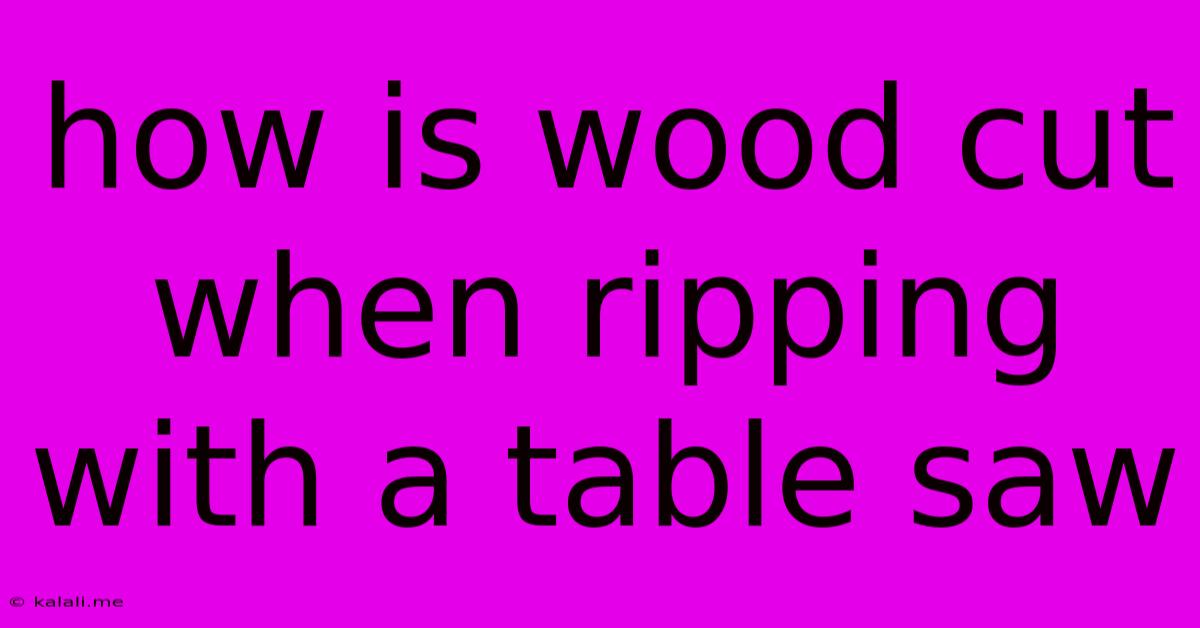How Is Wood Cut When Ripping With A Table Saw
Kalali
Jun 05, 2025 · 3 min read

Table of Contents
How is Wood Cut When Ripping with a Table Saw? Understanding the Process for Safe and Accurate Cuts
Ripping lumber with a table saw is a fundamental woodworking skill, allowing you to cut boards to precise widths. However, understanding how the wood is actually cut is crucial for safety and achieving accurate, clean rips. This article breaks down the cutting process, highlighting key factors influencing the cut quality and offering tips for success.
Understanding the Table Saw's Cutting Action:
The table saw uses a rotating blade, typically a circular saw blade with teeth specifically designed for ripping. These teeth are usually larger and fewer in number compared to crosscut blades, resulting in a smoother cut when ripping. When ripping, the wood moves past the stationary blade. The blade's teeth progressively shear the wood fibers, removing thin slivers of material with each rotation.
The Ripping Process Step-by-Step:
-
Setup is Key: Proper setup is paramount for safe and accurate ripping. This includes ensuring the blade is properly aligned (parallel to the miter gauge or rip fence), the fence is securely clamped, and the blade height is correctly adjusted (slightly above the thickness of the workpiece). Always double-check everything before turning on the saw.
-
Starting the Cut: With the blade running at full speed, the workpiece is fed into the blade using a push stick (never your hands!), keeping the wood firmly against the fence. Consistent pressure and a steady feed rate are essential for a smooth, straight cut.
-
The Shearing Action: The blade's teeth don't just slice through the wood; they progressively shear the fibers. This shearing action minimizes tear-out, particularly on the face of the cut away from the fence. The blade's speed and the feed rate interact to determine how effectively this shearing happens.
-
Managing Tear-Out: Tear-out is a common problem when ripping, especially on the exit side of the cut (the side facing away from the fence). Using a zero-clearance throat plate minimizes tear-out by preventing the wood from flexing and catching on the blade. Additionally, using a push block or featherboard helps control the workpiece and prevent it from binding or shifting. A sharp blade is also critical for minimizing tear-out. Dull blades lead to increased tear-out and a rougher cut.
Factors Influencing the Cut Quality:
- Blade Type and Sharpness: Using a blade specifically designed for ripping is vital. A sharp blade cuts cleaner and requires less force, minimizing tear-out.
- Blade Height: Setting the blade height slightly above the workpiece's thickness allows for a cleaner cut.
- Feed Rate: A consistent, moderate feed rate prevents the blade from overheating and ensures a smooth, even cut. Too slow a feed rate can lead to burning, while too fast a feed can cause tear-out.
- Workpiece Stability: Securing the workpiece against the rip fence ensures a straight cut and prevents binding or kickback. Using clamps or hold-downs can be beneficial for longer pieces.
- Wood Type: Different wood species react differently to ripping. Hardwoods generally require more care and a slower feed rate than softwoods.
Safety Precautions:
- Always use push sticks or featherboards. Never use your hands to guide the wood past the blade.
- Wear appropriate safety gear, including eye protection, hearing protection, and dust mask.
- Ensure the blade is sharp. Dull blades are more likely to cause kickback.
- Never reach over the blade.
- Keep your hands clear of the blade.
By understanding the mechanics of how wood is cut when ripping with a table saw, and by adhering to safe practices, you can significantly improve your woodworking skills, produce higher quality results, and work more safely. Remember, practice and attention to detail are key to mastering this essential woodworking technique.
Latest Posts
Latest Posts
-
Can You Buy A Toilet Tank Separately
Jun 06, 2025
-
Is Spirit Savers Club Worth It
Jun 06, 2025
-
Why Do You Let Him Eat Sand
Jun 06, 2025
-
Does Spraying Your Roof With Water Cool Your House
Jun 06, 2025
-
Can Muslims Have Sex During Ramadan
Jun 06, 2025
Related Post
Thank you for visiting our website which covers about How Is Wood Cut When Ripping With A Table Saw . We hope the information provided has been useful to you. Feel free to contact us if you have any questions or need further assistance. See you next time and don't miss to bookmark.